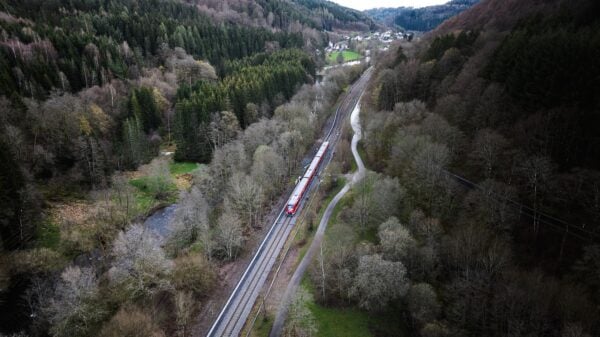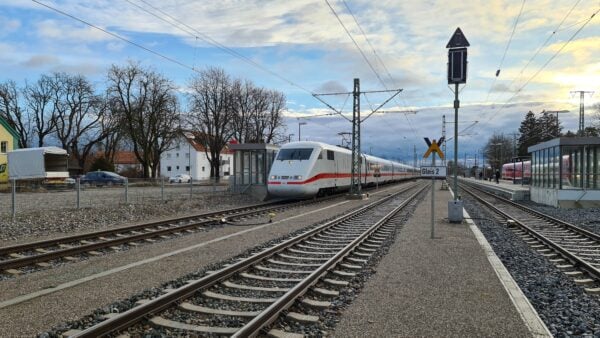CSM
Safety on the railways is of the highest priority. The Common Safety Method (CSM) plays a crucial role in ensuring these standards. Enotrac performs risk analysis in accordance with the regulations (EU) No. 402/2013 (CSM RA) and the 2015/1136 addendum. This includes organising risk analysis workshops, maintaining the hazard record, risk assessment, system definition, formulating safety requirements and demonstrating their fulfilment. Enotrac is involved in coordinating between different teams and external actors to maintain safety in the railway system and ensure that the highest safety standards are met. The CSM provides a structured framework for safety assessment in the railway sector.
Common Safety Method (CSM)
The Common Safety Method (CSM) is a central tool for ensuring safe operations in the railway sector. It comprises various methods and processes specifically designed to assess safety levels, achieve safety targets and ensure compliance with all relevant safety requirements. These methods have been developed to establish a uniform and standardised evaluation and safety monitoring procedure throughout the railway sector.
The CSM is particularly important when significant changes are made to railway systems, as it helps to identify and minimise risks. The focus is on the safety of technical systems and the associated modifications in the railway sector. The CSM thus enables compliance with the applicable safety regulations and standards, which is essential for safe and efficient railway operations.
A five-step process
The CSM Regulation (EU) 402/2013 prescribes a five-step process that must be followed when significant changes are made to railway systems. This process is of central importance to ensure the safety and efficiency of changes to the railway system and compliance with the regulation. The five steps of this process are as follows:
Step 1: System definition and change description
In this step, the affected system is defined and the planned changes are described. This also includes the risk management process, which is an integral part of the safety assessment.
Step 2: Identification of potential hazards and risk assessment
This is where possible hazards are identified and the risks associated with them are assessed. This is crucial to identify potential risks at an early stage.
Step 3: Specification of safety requirements
This stage involves defining detailed safety requirements that are necessary to minimise the identified risks and maintain the safety of the system.
Step 4: Verification and validation
This step involves verification and validation to ensure that the solutions developed meet the defined safety requirements. This is crucial to ensure the effectiveness of the measures implemented.
Step 5: Creation of a comprehensive safety assessment report
At the end of the process, a detailed safety assessment report is created that documents all steps and comprehensively assesses the safety of the modified railway system. This report serves as the basis for the approval and safe operation of the system.
Risk management process as a central element
A central element of this process is the risk management procedure, which includes risk assessment, safety case and the management of hazards and safety measures. This procedure is carried out and independently verified by qualified Enotrac experts. The proposer is responsible for risk management and maintains a hazard record. It is crucial that the risk management comprehensively covers both the system under assessment and its integration into the entire railway system.
Adherence to this process and to the CSM Regulation (EU) 402/2013 is essential to ensure rail safety. This makes it possible to identify potential risks at an early stage and minimise them, which is crucial for the safety of passengers and staff.
Conducting risk analysis
Conducting risk analysis, in particular as part of the risk management process in accordance with Implementing Regulation (EU) No. 402/2013 (CSM RA), is essential for identifying and evaluating hazards and risks associated with technical systems and the associated changes in the railway system. Enotrac carries out these risk analyses in accordance with the applicable regulations.
The risk assessment process is iterative and typically includes the steps of system definition, hazard identification, and risk evaluation. This process is carried out in close cooperation with hazard management and takes into account essential aspects such as the purpose of the system, its functions and components, interfaces, environment, existing safety measures and assumptions.
Risk assessment is a critical step in the risk management process that aims to understand and evaluate the extent of risks. It uses clear criteria to determine whether a particular risk is acceptable or if additional safety measures are needed. Risk assessment takes into account various factors, including the probability of a risk occurring and its potential impact on safety.
In situations where hazards are not covered by existing regulations or reference systems, an explicit risk assessment is carried out. Risk acceptance criteria are used to evaluate the acceptability of a risk. If a risk is deemed unacceptable, additional safety measures are defined.
The possibility of a reference system is also considered, provided that it fulfils comparable safety requirements and operates under similar conditions. If a reference system covers relevant hazards, the associated risks are considered acceptable and the corresponding safety requirements are documented.
Organisation, preparation and moderation of a hazard analysis workshop
The organisation, preparation and moderation of hazard analysis workshops are central elements of the CSM and risk management procedure carried out by Enotrac. These workshops are led by highly qualified experts and play a key role in identifying potential risks and hazards.
In the workshops, qualified teams systematically work under the direction of the proposer to identify possible hazards to the system. The identified hazards are prioritised according to estimated risk, with generally acceptable risks requiring no further analysis.
The identified hazards are examined to determine whether they can be controlled by safety measures, and these measures are carefully documented. In addition, existing regulations are reviewed to determine whether they adequately cover the identified hazards. If this is the case, the hazards are considered acceptable and the application of the relevant regulations is documented.
In cases where hazards are not adequately covered by existing regulations or where there are deviations from the regulations, proof of an equivalent safety level is required. These steps ensure a thorough analysis and prioritisation of hazards and compliance with safety standards. The results are recorded in a hazard report, which forms the basis for further measures.
Managing a team and coordinating interfaces within the various teams and with external stakeholders
Enotrac takes on the management of a team and coordinates the interfaces between different teams participating in the risk management process. This includes coordination with external actors such as independent experts. Close cooperation between the various parties is essential to ensure that the risk management process runs smoothly and that all relevant aspects are taken into account.
In the railway sector, various actors work together at the interfaces to identify hazards and coordinate safety measures. If necessary, responsibility for safety measures can be transferred between the actors. It is important that all parties are informed about issues related to safety measures, with the proposer taking responsibility for developing solutions.
Creation and maintenance of the hazard record
After the hazard analysis workshops, Enotrac prepares a hazard protocol that contains a detailed description of the identified hazards. This information is integrated into the identified hazards document.
The hazard log is regularly updated to document progress in monitoring hazards and risks. In the case of hazards that cannot be managed by a single actor, information sharing and collaboration is sought to identify appropriate solutions. This enables continuous monitoring and development of appropriate risk minimisation measures.
Creating the system definition for risk analysis
Creating a system definition for risk analysis is a crucial step and involves defining the system under consideration in detail, as well as identifying all the people, devices and procedures associated with it. An accurate and complete system definition is essential to adequately assess and manage the potential risks associated with the system and its components.
The definition of the system also includes the identification of interfaces to other systems or processes that are connected to the system under consideration. This helps to understand potential interactions and dependencies and to ensure that all relevant aspects are taken into account.
A clear system definition makes it possible to analyse the risks effectively, as it serves as a basis for understanding the impact of hazards on the system. It also helps to identify protective measures and safety requirements that are necessary to minimise these risks.
Creating the safety requirements specification
The specification of safety requirements is a further step in the risk management process. This involves formulating the requirements that must be met in order to minimise the identified risks, in accordance with the CSM RA. These safety requirements are crucial to ensuring that the system meets the highest safety standards. Comprehensive evidence is provided to demonstrate that all safety requirements have been fully met.
Creation of the safety requirements demonstration
Another aspect of the documentation concerns the proof of compliance with the safety requirements. This includes the presentation of the safety measures and precautions taken to limit the risks to an acceptable level. These proofs are essential to document that the defined safety objectives have been successfully realised. The safety requirements must be proven before a change is approved or before the safety assessment report is completed. The evidence is provided by the Enotrac experts responsible for the safety requirements and is verified by an independent assessment body.
This detailed description of the CSM procedure and the risk management process in the rail sector illustrates the need to maintain safety standards and procedures in the industry. This process makes it clear that the safety of passengers and staff is paramount and enables the continuous monitoring and improvement of safety in the rail industry. Adherence to the CSM Regulation and careful risk analysis are essential for the safe operation of railway systems and enable potential risks to be addressed proactively.





